Brianna Abbeya, Anahita Alipourb, Christopher Campc, Crystal Hoferc
aFaculty of Pharmacy and Pharmaceutical Sciences, University of Alberta, Edmonton, AB; bDepartment of Computing Sciences, University of Alberta, Edmonton, AB; cIndustrial Design, University of Alberta, Edmonton, AB
ABSTRACT
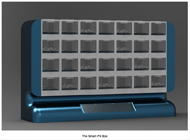 The Smart Pill Box
The Smart Pill Box
INTRODUCTION
Medication adherence is a significant problem the healthcare system currently faces. Roughly 50% of patients with chronic illnesses do not take their medications as prescribed. [1] Poor medication adherence can increase morbidity and death in patients. It has been estimated that poor medication adherence costs the United States $100 billion per year. [2] In the World Health Organization’s 2003 report [3], Adherence to long-term therapies, evidence for action, Haynes [4] was quoted that “increasing the effectiveness of adherence interventions may have a far greater impact on the health of the population than any improvement in specific medical treatments.”
According to Statistics Canada [5], the average Canadian, in 2005, had 14 prescriptions for that year and Canadians between the ages of 60 and 79 had 35 prescriptions in 2005. Canadians, 80 years and older, received on average 74 prescriptions in 2005. Over 75% of individuals over 65 years of age are prescribed prescription medications and they take three or more medications per day. [6] Reach [7] states that:
The information that a patient must remember in order to take just one pill is actually complex and is made up of seven properties: the name of the drug, for which disease it is used, how to take it, the number of daily intakes, when to take it (before, during, or after a meal), dosage, and duration of the treatment.
The complexity of medication regimens and the pill burden patients face impacts medication adherence.
BACKGROUND
There are a few different devices that are widely available to patients to aid in medication adherence. Dosettes are commonly used by patients and are offered in a variety of sizes and dosing schedules. However, dosettes can be confusing to fill and their basic design offers no notification or monitoring features and they are rarely cleaned by their users. Blister packaging is available at most pharmacies and patients with complex medication schedules or high pill burdens often use this service. Blister packaging ensures that the medication is correctly scheduled for a patient, but does not guarantee adherence. Patients do not receive notifications to take their medication and therefore the patient must remember to take their medication. Individuals with arthritic hands may find it hard to remove the pills from the blister cards and this could negatively affect adherence.
MedSignals® is a medication device that is currently on the market. [8] It is designed with four bins (one bin per pill type) and is programmed to provide notifications to the user at scheduled times. It monitors medication adherence by monitoring when a door to a bin is opened. Problems with the MedSignals® device were found when the device was tested with two patients at the Glenrose Rehabilitation Hospital. The bins were small, which made it difficult for individuals to remove the medication from the bin. It was difficult to program the device and the device only allowed for four medications. The monitoring of the device was inaccurate, because the patient opened the bin’s doors multiple times because of pill spillage and confusion. Finally, the design of the device was counter-intuitive. The patient had to open multiple bins to remove their scheduled pills for a particular dosage time.
DESIGN OBJECTIVE
The purpose of this interdisciplinary project was to develop a medication device that increased medication compliance, monitored medication taking behavior, and communicated with patients, caregivers, and pharmacists.
METHODS / APPROACH
The team started the design process by researching current medication devices. After looking at the limitations of each device, we composed a list of key features/ objectives we thought were essential to include in our design. Our design needed to be intuitive, user friendly, simple, flexible, and portable. The design needed to be able to notify the user, monitor the user’s medication adherence and the device would be for scheduled oral medication. The device needed to have one bin per dosage time, rather than one bin per pill type. With these features/objectives in mind, we started to develop designs. We used research and simple experiments to develop our design. The team carefully debated each detail to include in our design.
The Design
 Figure 1: Orthographic diagram of The Smart Pill Box.
Figure 1: Orthographic diagram of The Smart Pill Box.
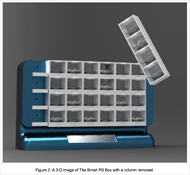 Figure 2: A 3-D image of The Smart Pill Box with a column removed.
Figure 2: A 3-D image of The Smart Pill Box with a column removed.
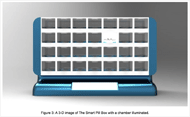 Figure 3: A 3-D image of The Smart Pill Box with a chamber illuminated.
Figure 3: A 3-D image of The Smart Pill Box with a chamber illuminated.
The Application
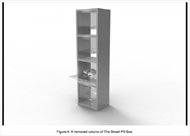 Figure 4: A removed column of The Smart Pill Box.
Figure 4: A removed column of The Smart Pill Box.
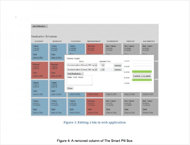 Figure 5: The Application
Figure 5: The Application
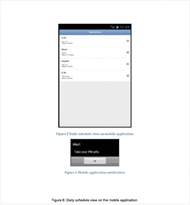 Figure 6: Daily schedule view on the mobile application.
Figure 6: Daily schedule view on the mobile application.
DISCUSSION / OUTCOMES / PERFORMANCE/ IMPLICATIONS
 Figure 7: The daily view (left), the details view (center), and the information view (right)
Figure 7: The daily view (left), the details view (center), and the information view (right)
With an aging population, medication adherence will continue to be an issue and the pill box can help increase patient adherence. According to Industry Canada [9] in 2006, 72% of Canadians aged 35-54 years own a cellphone and 48% of Canadians aged 55 years and older own a cellphone. These statistics show the feasibility of using a mobile application to aid in notifying a patient to take their medication. The baby-boomer population is fairly comfortable using a variety of technologies. Currently and as this population continues to age, we hope they will become more comfortable with using technology to assist them in taking their medication. Involving caregivers and pharmacists in the function of the pill box really helps give patients the support and care that they need to take their medication and adds a social component to the device. We hope that the interactive and flexible features of the pill box translate into patient uptake of the device.
Testing has been completed with The Smart Pill Box’s sensors and the web based application. Further research is needed to evaluate more precisely the effectiveness of The Smart Pill Box. Testing with different segments of the population is needed to assess individual interactions with the device and to measure medication adherence.
REFERENCES
[1] Brown, M., Bussell J. (2011) Medication Adherence: WHO cares? Mayo Clinic Proceedings.86 (4), 304-314.
[2] Osterberg, L., & Blaschke, T. (2005). Adherence to medication. New England Journal of Medicine. 353 (5), 487-497.
[3] Sabate, E. (2003). Adherence to long-term therapies, evidence for action. Geneva, Switzerland.World Health Organization.
[4] Haynes, R. (2001). Interventions for helping patients follow prescriptions for medications. Cochrane Database Systematic Review. (1).
[5] Ramage-Morin, P. (2009). Component of Statistics Canada catalogue. Statistics Canada. 20 (1).
[6] Ostrom, J., Hammarlund, E., Christensen, D., Plein, J., & Kethley, A. (1985). Medication usage in an elderly population.
Med Care. 23 (2), 157-164.
[7] Reach, G. (2009). Can technology improve adherence to long-term therapies? Journal of Diabetes Science and
Technology. 3 (3) 492-499
[8] Medsignals. (2011). Retrieved December 4, 2011, from http://www.medsignals.com
[9] Office of Consumers Affairs. (2011). The expansion of cellphone services. Industry Canada. Retrieved November 8, 2011, from http://www.ic.gc.ca/eic/site/oca-bc.nsf/eng/ca02267.html
ACKNOWLEDGEMENTS
This work was developed through the interdisciplinary design course at the University of Alberta in Edmonton, Alberta. The disciplines involved in the design course were computing sciences, industrial design, occupational therapy, and pharmacy. We would like to acknowledge our instructors: Robert Lederer, Lili Liu, Greig Rasmussen, Eleni Stroulia, and Cheryl Sadowski.